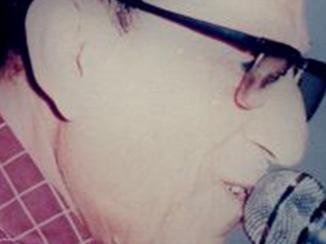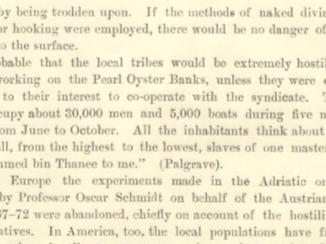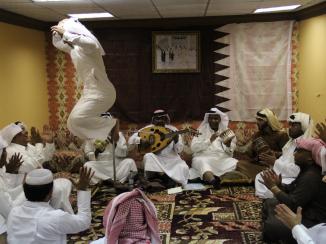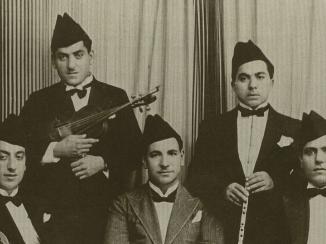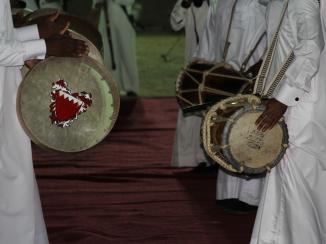Overview
Though the ṣawt music of different countries is closely related, a specific type within this early urban genre has developed in Bahrain. In his liner notes to the 1994 album Anthologie de la musique Arabe: La musique de Bahreïn, the musicologist Ahmed Hachlef for instance mentions the ‘three undisputed masters of Bahraini music’, listing Mohamed Bin Fares (1895–1947/48), Dhahi Bin Walid (1896/98–1941) and Fares’ student Muhammad Zuwayyid (1900–82). Today, the two singers and oud (Arabic lute) players, Fares and Walid, are regarded by ethnomusicologist Poul Rovsing Olsen as the founders of the Bahraini style of sawt.
The origin of ṣawt music in Bahrain (and earlier in Kuwait) is probably related to the fact that the country sits at the crossroads of cultural influences from across the Gulf region – Kuwait, Qatar, Persia, southern Iraq (particularly Basra), Saudi Arabia and Oman – as well as from further afield such as Yemen and India.
Since the early days of ṣawt music in the first quarter of the twentieth century, there has been collaboration between musicians from Bahrain and Kuwait. However, the origin of the poetry that informed the melodic lines can be traced to Yemen and the Ḥijāz region in western Saudi Arabia. Though most sources agree that ṣawt as it exists today was first established in Kuwait by the poet, composer, singer and oud player Abdallah al-Faraj (1836–1901/1903), Dhahi Bin Walid and Mohamed Bin Fares are also regarded as prominent contributors to the genre and credited for developing it further.
The Masters and Their Music
Ṣawt consists of two completely interwoven elements: the scale and method of playing the oud, which are taken from Arabic Classical music, together with the polyrhythmic structure and lyrics of the Haḍar, Bedouin and fishing communities’ musical traditions. Mohamed Bin Fares and Dhahi Bin Walid were heavily influenced by musical genres prevalent in their time, but they created their own style clearly based on the traditional music of the Gulf.
Musical and Personal Origins
Bin Fares’ influences encompass musical genres beyond the Gulf. In the 1920s, he travelled to India – where he learned about Indian music – and to Iraq and Syria where he learned to play the oud. In the 1930s, he spent lengthy periods in Bombay, where he studied with his mentor ‘Abd al-Rahim al-‘Asiri, who was either Yemeni or Saudi. After a lengthy period of travel, he finally settled in Bahrain, where Dhahi Bin Walid and Muhammad Zuwayyid became his most successful students. There he applied the knowledge acquired abroad to the traditional music genres prevalent at the time.
Dhahi Bin Walid had very different musical and personal origins. Although, he was born in Muharrak (Bahrain), he was the son of an East African from Saudi Arabia. This may have influenced his musicality at an early age. Before he started to play the oud, he accompanied Fares on the mirwās drum. He also worked as a nahhām – a professional singer on a pearl diving boat – for some time. Eventually, however, his remarkable ability to remember lyrics and melodies and his formidable performance skills made him a leading performer in the Gulf.
Unfortunately, Bin Walid’s increasing popularity and musical ability brought him into fierce competition with his former mentor Bin Fares. The legend goes that at one stage they stopped speaking to each other for several years, only to be reconciled for the HMV (‘His Master’s Voice’, part of Gramophone Company, London) recording sessions in the early 1930s in Baghdad.
Bahraini ṣawt, created by these two innovators, with the contribution of Muhammad Zuwayyid, later became important throughout the Gulf region.
The Recordings
Although the first audio recordings in the Gulf region were made in Bahrain after the Second World War, according to Ahmed Hachlef’s liner notes, the recordings from Bin Walid and Bin Fares featured here were most likely recorded in 1931 or 1932 at the HMV studio in Baghdad. Apart from a few earlier Kuwaiti recordings, these constitute the earliest commercial recordings of music from the Gulf region.
Though Fares had contact with other musical cultures, especially in India, the two musicians were pivotal in creating a musical genre essentially unique to the Gulf. They have become an inspiration to many musicians; even today, musicians play their songs and refer to them as their ustads – or masters.
Listen to:
Playlist Bahrain:

